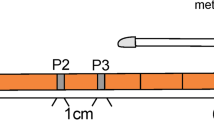Abstract
Background
Undetected bowel perforations occur in 0.3–1% of laparoscopic surgical procedures with an associated mortality rate of 5.3%.
Objective
The purpose of the study was to evaluate the clinical feasibility of a novel medical device to accurately detect bowel gas, specifically hydrogen (H2) and methane (CH4), from a sample of gas from the abdominal cavity during laparoscopic surgery when a known bowel wall perforation has occurred. Setting: University (Academic) Hospital.
Methods
A prospective single arm study was composed of 8 patients undergoing a standard laparoscopic roux-en-y gastric bypass. At seven time points during the operation intra-abdominal gas was pulled from the abdominal cavity and analyzed using the novel device for H2 and CH4. The time points included after insufflation (T1), after first jejunotomy (T2), after closure of jejunotomy (T3), after recycle of carbon dioxide gas (T4), after gastrostomy (T5), after jejunotomy (T6), at procedure end (T7).
Results
Eight patients were enrolled in the study; in 7 (87.5%) patients data from all 7 time points were obtained. After the first opening of the small bowel (T2) mean hydrogen levels were significantly increased compared to baseline hydrogen levels (T1, T4, T7) (p < 0.001). At all time points, there was no significant detection of methane. There were no intra-operative or post-operative complications during the study.
Conclusion
Hydrogen gas is released into the intra-abdominal cavity when bowel is opened and can be detected in real time using a novel device during laparoscopic surgery. The presence or absence of hydrogen directly correlates to whether the bowel is open (perforated) or intact. This device could be used in the future to detect unintended bowel perforations during laparoscopic surgery, prior to the conclusion of the operation. This technology could also potentially lead to novel mechanism for detecting postoperative leaks using gas detection technology.



Similar content being viewed by others
References
Al-Qurayshi Z, Srivastav S, Slakey DP, Kandil E (2016) Risk of intraoperative injury of nearby structures: national trend, distribution, and burden. J Am Coll Surg 222:624–631
van der Voort M, Heijnsdijk EA, Gouma DJ (2004) Bowel injury as a complication of laparoscopy. Br J Surg 91:1253–1258
Schwartz MJ, Faiena I, Cinman N, Kucharczyk J, Meriggi JS, Waingankar N, Richstone L, Kavoussi LR (2010) Laparoscopic bowel injury in retroperitoneal surgery: current incidence and outcomes. J Urol 184:589–594
Dindo D, Schafer M, Muller MK, Clavien P-A, Hahnloser D (2010) Laparoscopy for small bowel obstruction: the reason for conversion matters. Surg Endosc 24:792–797
Wullstein C, Gross E (2003) Laparoscopic compared with conventional treatment of acute adhesive small bowel obstruction. Br J Surg 90:1147–1151
Suter M, Zermatten P, Halkic N, Martinet O, Bettschart V (2000) Laparoscopic management of mechanical small bowel obstruction. Surg Endosc 14:478–483
Llarena NC, Shah AB, Milad MP (2015) Bowel injury in gynecologic laparoscopy: a systematic review. Obstet Gynecol 125:1407–1417
Galleano R, Franceschi A, Ciciliot M, Falchero F, Cuschieri A (2011) Errors in laparoscopic surgery: what surgeons should know. Minerva Chir 66:107–117
Deffieux X, Ballester M, Collinet P, Fauconnier A, Pierre F, Obstetricians FNCoGa (2011) Risks associated with laparoscopic entry: guidelines for clinical practice from the French College of Gynaecologists and Obstetricians. Eur J Obstet Gynecol Reprod Biol 158:159–166
Singh JP, Steward MJ, Booth TC, Mukhtar H, Murray D (2010) Evolution of imaging for abdominal perforation. Ann R Coll Surg Engl 92:182–188
Feldman M, Friedman L, Brandt L (2015) Fordtran’s Gastrointestinal and liver disease—pathophysiology, diagnosis, management, 10th edn, Saunders
Sharma M, Makharia G (2000) Intestinal gas—its syndromes. JK Science 2:75–80
Sahakian AB, Jee SR, Pimentel M (2010) Methane and the gastrointestinal tract. Dig Dis Sci 55:2135–2143
Sosna J, Bar-Ziv J, Libson E, Eligulashvili M, Blachar A (2008) CT colonography: positioning order and intracolonic pressure. AJR Am J Roentgenol 191:1100
Funding
The company made the device available at no cost and provided support for its use. No funding was received for this trial.
Author information
Authors and Affiliations
Corresponding author
Ethics declarations
Disclosures
Dr. Elisabeth Wynne and Dr. Dan Azagury have no conflicts of interest or financial ties to disclose.
Additional information
Publisher’s Note
Springer Nature remains neutral with regard to jurisdictional claims in published maps and institutional affiliations.
Rights and permissions
About this article
Cite this article
Wynne, E.K., Azagury, D.E. Novel device to detect enterotomies in real time during laparoscopy: first in human trial during Roux-en-y gastric bypass. Surg Endosc 33, 1687–1692 (2019). https://doi.org/10.1007/s00464-018-06637-2
Received:
Accepted:
Published:
Issue Date:
DOI: https://doi.org/10.1007/s00464-018-06637-2




